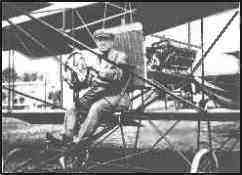

Glenn Curtiss in the background
 |
 |
||
| Captain Thomas S. Baldwin. | Captain Baldwin in his "Red Devil" in 1912 Glenn Curtiss in the background |
|
"The public disbelief in flight, however, extended only to heavier-than-air craft. Dirigible balloons, filled with hydrogen gas and fitted with engine, propeller, elevator, and rudder, were known to have operated successfully. Captain Thomas Scott Baldwin in the United States, Alberto Santos-Dumont in France, Count Ferdinand von Zeppelin in Germany, were building and flying airships without great fanfare or furor. Captain Thomas S. Baldwin, California's pioneer dirigible balloonist, brought Curtiss into the flying fold by ordering one of the lightweight Curtiss motorcycle motors for his nonrigid, gas-inflated, cigar-shaped airship. Baldwin built more than a dozen dirigibles, all equipped with Curtiss motors, and in the summer of 1908 delivered a specially constructed military model to the Aeronautical Division of the U.S. Army Signal Corps in Washington. With Baldwin operating the controls from the rear of the skeleton framework and Curtiss, balanced up forward, looking after the motor, the craft easily met government specifications in a two-hour flight over the Virginia countryside. 1909 The New York World announced a prize of $10,000 for the first flight between New York and Albany. Two attempts by dirigible, one by Thomas Baldwin and one by George T. Tomlinson, had ended in failure. 1909 New York played host to twenty-seven of the world's leading flyers at the Belmont Park racetrack on Long Island. Momentarily at least, the pendulum of activity seemed to be swinging back to America. A total of $72,300 in prize money was a stake -- of which $10,000 was earmarked for the winner of a race around the Statue of Liberty.Top billing, however, was given to the second contest for the Gordon Bennett trophy. Charles K. Hamilton entered his Hamiltonian - biplane modeled on the Curtiss and powered by an eight-cylinder, 110-hp motorcar engine designed by Walter Christie. Captain Thomas Baldwin appeared with the Red Devil, constructed on the same order. 1910 The Post-Dispatch decided to attempt a demonstration, to the people of St. Louis, that aviation was a reality. Clifford Harmon, an Eastern amateur flyer, was invited to come here and make a flight along the river front, for a prize to be offered by this newspaper. Officials of the air meet co-operated in the plan, though it had an element of risk, for another failure might have killed the prospects of the meet scheduled for the following month. Harmon agree to come here, and sent Capt. Tom Baldwin, noted acrobat and professional hot-air balloon jumper, here to look over the ground. For some reason, Harmon appeared to lose interest in the matter. "Never mind," said Capt. Baldwin, when he reported this condition of affairs. "If Harmon doesn't fly, I will." He meant it and presently he brought to St. Louis his "Red Devil" airplane, a heavy and clumsy-looking affair which resembled a farmer's wagon more than it resembled the neat machines which Curtiss had displayed. But it would fly, and it did fly, with the stout and middle-aged Baldwin in it, the afternoon of Sept. 10, 1910. The starting point was a field between Calvary Cemetary and the river, and the route was down the Mississippi to Carondelet. A large part of the city's population saw the flight, thousands of persons standing on Eads Bridge and cheering wildly as Baldwin flew over the bridge. He was not expected to return by air, but he did so, and electrified the spectators by flying under the east span of Eads Bridge at 50 miles an hour, and under McKinley Bridge. This scooting under bridges was a feat of pure dare-deviltry and has not been performed here since, so far as is now recalled, by any flyer in an airplane without a boat attached. The Baldwin demonstration entirely changed the views of St. Louisans about aviation, and made it certain that the meet, the following month, would be a success from the start. 1911 On April 23, 1911, Captain Yoshitoshi Tokugawa, a twenty-seven-year-old first lieutenant in the Japanese engineer corps, set a Japanese record with the Blériot, flying 48 miles in 1 hour 9 minutes 30 seconds. These pioneer flights antedated by many months the appearances of Thomas Baldwin and other American flyers who began touring Japan for exhibition purposes in the latter part of 1911. 1916 Captain Tom was a wonderful man and it was a pleasure to work for and with him. However, he had his pecularities like we all have. For example, he wouldn't attend the funerals of any of the boy that were killed. He told me confidentially that he just couldn't take it. Once my wife and I had him out to dinner at the Pressey residence. Loa had prettied up the table very nice with flowers, a centerpiece, etc. Capt. didn't seem to notice it, and had only been there a few minutes when he exploded with, "Well, when do we eat. I came here to eat." He was a lovable character, even though rough in his talk at times. 

|